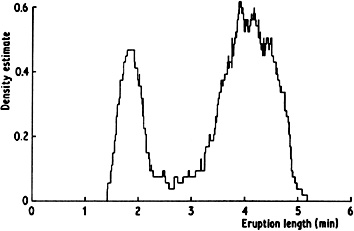


2.3. The naive estimator
From the definition of a probability density, if the random variable X has density f, then

|
For any given h, we can of course estimate
P(x - h < X < x + h) by the
proportion of the sample falling in the interval
(x - h, x + h). Thus a natural estimator
 of the
density is given by choosing a small number h and setting
of the
density is given by choosing a small number h and setting

|
we shall call this the naive estimator.
To express the estimator more transparently, define the weight function w by

| (2.1) |
Then it is easy to see that the naive estimator can be written

|
It follows from (2.1) that the estimate is constructed by placing a `box' of width 2h and height (2n h)-1 on each observation and then summing to obtain the estimate. We shall return to this interpretation below, but it is instructive first to consider a connection with histograms.
Consider the histogram constructed from the data using bins of width
2h. Assume that no observations lie exactly at the edge of a
bin. If x
happens to be at the centre of one of the histogram bins, it follows
at once from (2.1) that the naive estimate
 (x)
will be exactly the
ordinate of the histogram at x. Thus the naive estimate can be
seen to
be an attempt to construct a histogram where every point is the centre
of a sampling interval, thus freeing the histogram from a particular
choice of bin positions. The choice of bin width still remains and is
governed by the parameter h, which controls the amount by which the
data are smoothed to produce the estimate.
(x)
will be exactly the
ordinate of the histogram at x. Thus the naive estimate can be
seen to
be an attempt to construct a histogram where every point is the centre
of a sampling interval, thus freeing the histogram from a particular
choice of bin positions. The choice of bin width still remains and is
governed by the parameter h, which controls the amount by which the
data are smoothed to produce the estimate.
The naive estimator is not wholly satisfactory from the point of
view of using density estimates for presentation. It follows from the
definition that
 is not a
continuous function, but has jumps at the
points Xi ± h and has zero derivative
everywhere else. This gives the
estimates a somewhat ragged character which is not only aesthetically
undesirable, but, more seriously, could provide the untrained observer
with a misleading impression. Partly to overcome this difficulty, and
partly for other technical reasons given later, it is of interest to
consider the generalization of the naive estimator given in the
following section.
is not a
continuous function, but has jumps at the
points Xi ± h and has zero derivative
everywhere else. This gives the
estimates a somewhat ragged character which is not only aesthetically
undesirable, but, more seriously, could provide the untrained observer
with a misleading impression. Partly to overcome this difficulty, and
partly for other technical reasons given later, it is of interest to
consider the generalization of the naive estimator given in the
following section.
A density estimated using the naive estimator is given in Fig. 2.3. The `stepwise' nature of the estimate is clear. The boxes used to construct the estimate have the same width as the histogram bins in Fig. 2.1.

|
Fig. 2.3 Naive estimate constructed from Old Faithful geyser data, h = 0.25. |